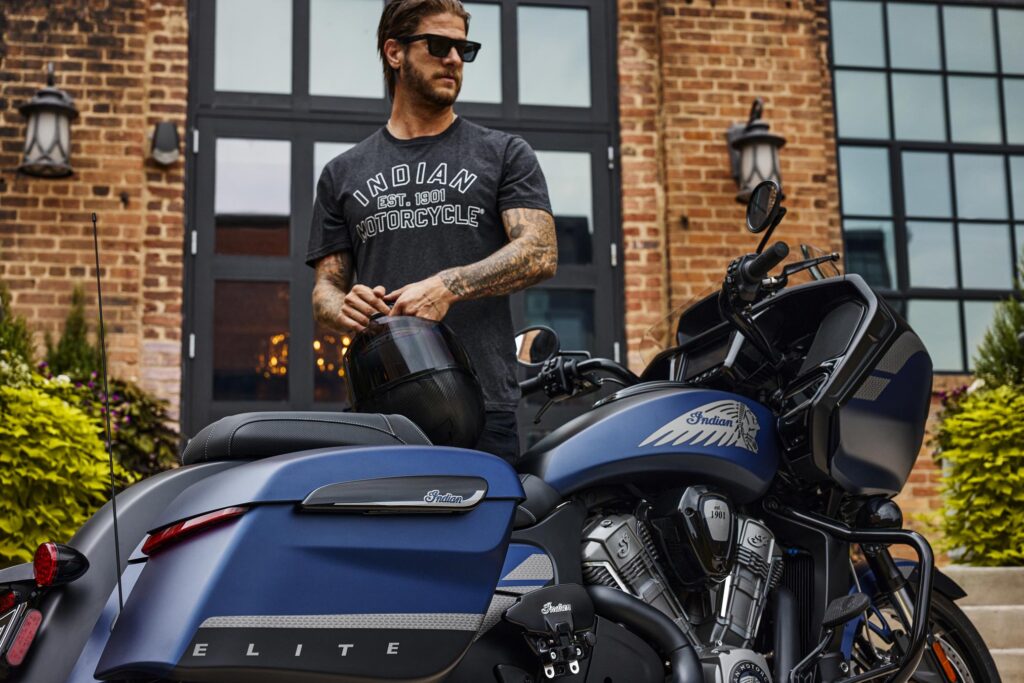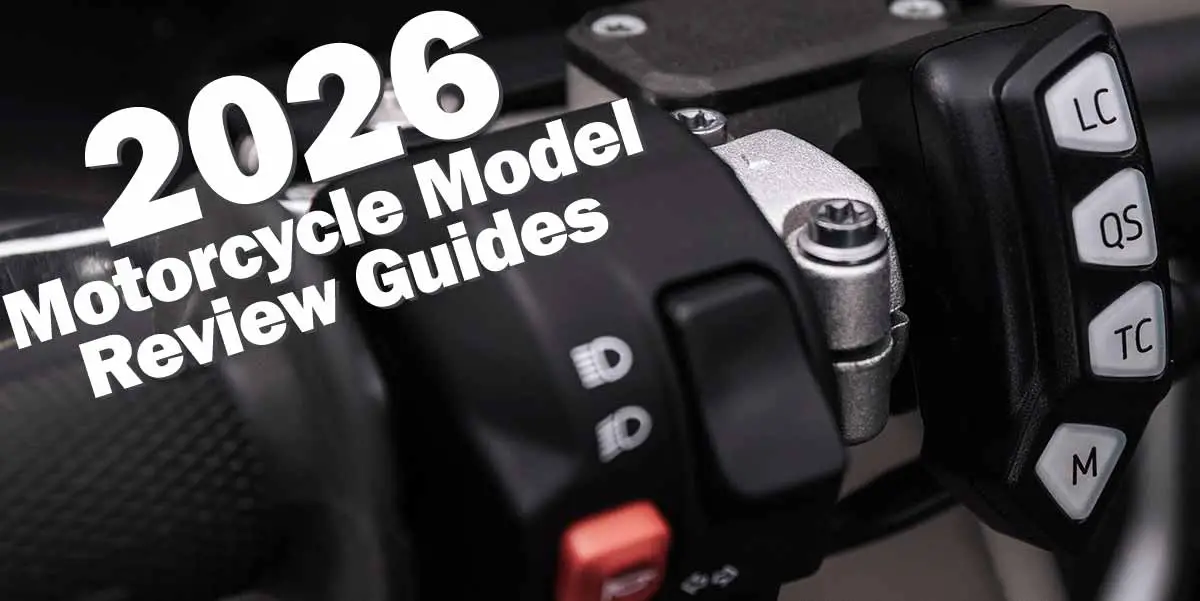Section Three: Basic Styles of Motorcycles
So many different bikes to choose from, where do you start? Honda, Suzuki, Kawasaki, Yamaha, Harley, Triumph, BMW, they all make the right bike for you, and this section will help you find out what that “right bike” is!
Have fun out there, enjoy the ride and be safe. – Mike Le Pard (webmaster)

The Basic Styles of Motorcycles
- Standard / Naked / Traditional / Muscle Bike / Commuter
- Cruiser / Custom / Choppers / Muscle Cruiser
- Sport Bike / Crotch Rocket / Super Sport / Hyper Sport
- Sport Touring / Performance Tourer / Cruiser Tourer
- Touring / Luxury Touring
- Dual Sport / Dual Purpose
- Dirt Bike / Off-Road Bike

Standard / Naked / Traditional / Muscle Bike / Commuter
These motorcycles place the foot pegs and shifter in a natural position (slightly forward, directly below, or slightly rearward of the waist), creating a comfortable upright seating posture. Handlebars are designed to avoid wrist or tailbone strain. The look is clean and uncluttered: exposed engine, minimal plastic, small or no fairing, and a long seat.
Standard/Naked bikes are versatile and affordable, balancing performance, practicality, and comfort. They are highly customizable, easily adapted into sport bikes, dirt bikes, cruisers, or even touring machines with the right accessories. They come in sizes from 50cc to 1300+cc, with engine types ranging from singles to inline-fours, V-twins, V4s, and boxers.
Variations include Muscle Bikes (stuffed with the largest, torque-heavy engines possible for adrenaline thrills) and Commuters (small, fuel-efficient city bikes with the same upright ergonomics).
This category nearly disappeared in the late 1980s and early 90s due to the rise of cruisers and sport bikes, but has since returned strongly. Standards are among the easiest bikes for beginners to learn on, thanks to their balance, intuitive controls, lighter weight, and lower repair costs if dropped. They remain the most adaptable “do-it-all” motorcycles.

Cruiser / Custom / Choppers / Muscle Cruiser
Cruisers place the foot pegs and shifter forward, allowing legs to stretch out. Handlebars are often higher or wider, creating a laid-back riding style. Comfort varies, some are relaxed, others put too much weight on the tailbone. Styling is paramount: exposed engines, custom seats, minimal plastic, and loads of chrome. On some models, the chrome and accessories can weigh as much as the engine itself.
Cruisers are boulevard machines, designed to look good parked or rolling slowly down Main Street. They are also highly customizable, with acres of chrome and accessories available. Choppers are a radical variation, with raked-out forks, banana seats, and stripped-down frames. Muscle Cruisers take the cruiser form and add oversized, torque-rich engines borrowed from muscle or sport bikes.
Most cruisers use V-twin engines for low-end torque and distinctive sound. Sizes range from 50cc to 1800cc. They dominate the American and Canadian markets but are sold worldwide. Cruisers are not the easiest bikes for beginners due to their ergonomics and weight, but their low seat heights make them accessible to shorter riders. Repair costs can be high due to chrome and accessories.
If this style appeals to you, you’re in luck, nearly every manufacturer offers multiple cruiser models to fit different budgets and tastes. They remain one of the most popular motorcycle categories today.

Sport Bike / Crotch Rocket / Super Sport / Hyper Sport
Sport bikes place the foot pegs and shifter rearward, creating an aggressive, aerodynamic riding position. Handlebars are low and angled to bend the rider into a streamlined shape, ideal for quick reflexes and cornering. This position can put pressure on the wrists and be uncomfortable for long rides, but it maximizes control and speed. Styling is jet-fighter inspired: hidden engines, short seats, and aerodynamic fairings sculpted in wind tunnels.
Sport bikes are designed for speed, agility, and racing. They feature cutting-edge engines, lightweight alloy frames, and advanced suspension systems. Manufacturers offer models from entry-level 250cc learners to 1300cc “rocket ships.” While some can be adapted for commuting or touring, their true home is the racetrack or twisty roads. Unfortunately, they also account for a high proportion of motorcycle accidents.
Unlike Standards, the engine defines this category, engineered for maximum horsepower and minimal weight. Most use inline-four engines capable of revving beyond 14,000 RPM, though twins, triples, V4s, and boxers are also found. Variations include Super Sport and Hyper Sport bikes, which are even more extreme: clip-on handlebars below the triple tree, lighter weight, and racetrack-derived engines.
Sport bikes have been around as long as motorcycle racing itself. A century ago, a 1000cc sport bike might have produced 12 horsepower; today, the same displacement can produce over 120. Manufacturers know that “win on Sunday, sell on Monday” drives sales, so racing success directly influences showroom demand.
Moderate sport bikes (like the Ninja 250 or EX500) can be suitable for beginners, with intuitive controls and good balance. However, they are expensive to repair if dropped due to their extensive plastic fairings. More extreme models are best left to experienced riders.
Sport Touring / Performance Tourer / Cruiser Tourer
These bikes place the foot pegs and shifter in a natural position, creating a comfortable upright seating posture similar to a Standard. Handlebars are designed to reduce wrist and tailbone strain, while the overall design is more aerodynamic and performance-oriented than a traditional touring bike.
The difference between a Performance Tourer and a Luxury Tourer lies in priorities: Performance Tourers emphasize speed, agility, and lighter weight, while Luxury Tourers focus on comfort, amenities, and smoothness. Cruiser Tourers fall in between, offering cruiser styling with added touring comfort.
Touring bikes typically include windscreens, luggage, comfortable seating for two, larger gas tanks, and shaft drive. Performance and Cruiser Tourers can be customized with accessories like adjustable windshields, heated grips, GPS, cruise control, passenger armrests, and more. Engines range from 500cc to 1800+cc, with inline-fours, V-twins, V4s, and smooth boxer configurations.
Performance Tourers are popular worldwide, appealing to riders who want sport bike handling with long-distance capability. However, they are not ideal for beginners: they can be top-heavy, large, and expensive to repair due to extensive fairings and chrome. New riders are better off starting with a Standard and outfitting it for touring.
Touring / Luxury Touring
Touring and Luxury Touring motorcycles also use a natural upright seating position, prioritizing comfort and amenities over performance. They are the “motorhomes” of the motorcycle world, designed for long-distance travel with maximum convenience.
Compared to Performance Tourers, Luxury Tourers emphasize smooth engines, plush seating, large storage, and extensive luxury features. They often include windscreens, hard luggage, heated grips, stereos, GPS, cruise control, and even passenger armrests or cup holders. Engines are typically large-capacity inline-fours, V-twins, V4s, or boxer 4/6-cylinder designs for maximum smoothness.
Luxury Tourers are especially popular in North America, though touring bikes in general have global appeal. They represent decades of refinement, offering supreme comfort for riders who want to travel very long distances in style. However, they are not beginner-friendly: their size, weight, and top-heaviness make them difficult to handle at low speeds, and some even require reverse gears. Repair costs are also high due to extensive plastics and chrome.
For new riders, it’s better to start with a Standard motorcycle and gradually build it into a touring setup with windshields, luggage, and comfort upgrades.

Dual Sport / Dual Purpose / Adventure Bike
Dual Sports place the foot pegs and shifter below the waist in a natural position, creating a comfortable upright seating posture. Handlebars are designed for easy slow-speed turning without wrist strain. These bikes have a basic look: exposed engines, long seats, light weight, minimal plastic, higher seat heights, long suspensions, and usually no fairings.
They are built to handle a wide range of riding conditions, both on- and off-road. With legal road gear (headlights, turn signals, mirrors) and versatile designs, they offer unbeatable enjoyment on dirt and asphalt alike. Dual Sports perform better than street bikes in the dirt and better than dirt bikes on the street, making them highly sensible motorcycles worldwide.
Most Dual Sports use single-cylinder engines (50cc–650+cc) for simplicity and torque, though some use V-twins or boxer engines. A popular variation is the Adventure Bike, essentially a larger, more powerful Dual Sport with higher carrying capacity, more lights, and greater mass. Adventure bikes excel in remote wilderness or long-distance mixed-surface travel.
The category emerged in the 1970s, when dirt bikes were fitted with road gear and small standards gained dirt tires and longer suspension. Riders loved being able to ride to the trails instead of hauling bikes by truck. Dual Sports are beginner-friendly thanks to their balance, light weight, and low repair costs, though taller seat heights can challenge shorter riders.
If you want one bike that can take you anywhere, dirt, gravel, or pavement, this is the style for you.

Dirt Bike / Off-Road Bike
Dirt bikes share the upright, natural riding position of Dual Sports, with handlebars designed for control at low speeds. They are stripped-down machines: exposed engines, short seats, very light weight, plastic fuel tanks, minimal bodywork, long suspensions, large-diameter tires, and no fairings. They are purpose-built for dirt, mud, sand, and rough terrain.
Off-road motorcycles come in two main varieties: Motocross and Off-Road models. Motocross bikes are tuned for racing, with specialized suspension and lightweight single-cylinder engines. Off-Road models range from family-friendly trail bikes to competition-ready machines for extreme terrain.
Dirt bikes are typically smaller (50cc–400cc) and use single-cylinder engines for torque and nimble handling. Their distinctive “killer-bee” sound comes from these high-revving singles. The category grew rapidly in the 1960s as riders discovered the fun of off-road riding and racing, and sales boomed thanks to their low cost, light weight, and ease of repair.
While dirt bikes are easy to ride, they are not ideal for beginners learning road skills because they lack street-legal equipment (mirrors, horns, turn signals). For new riders, a Dual Sport is a better choice unless you only plan to ride off-road. Still, dirt bikes are fantastic for kids and adults alike, offering light weight, balance, and endless fun in the dirt.




